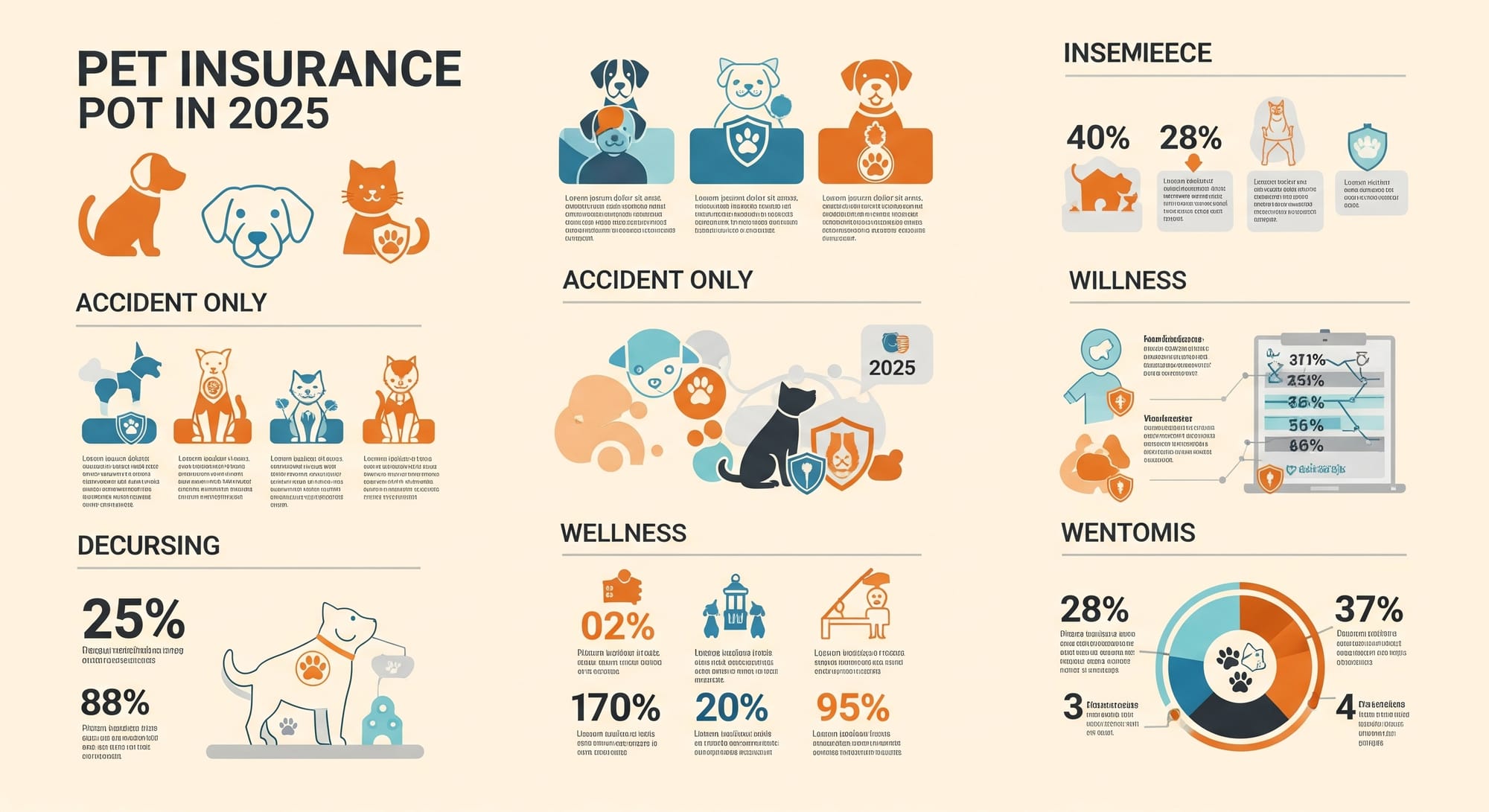How Pet Insurance Works

Pet insurance acts more like a reimbursement plan than human health coverage. You pay the vet bill up front, submit a digital claim, and the insurer sends back 70 – 100 percent of eligible costs after your deductible clears. Most U.S. providers sell three core policy types:
- Accident-only: Broken bones, lacerations, swallowed toys.
- Accident & illness (A&I): Adds cancer, allergies, diabetes, hip dysplasia.
- Wellness add-ons: Covers routine exams, shots, and dental cleanings.
Reimbursement usually arrives within 2–14 days, but companies such as Trupanion and Healthy Paws can pay the clinic directly. Knowing that timeline helps you decide whether to keep a separate emergency fund or rely fully on the policy.
Average Cost of Pet Insurance in the United States
New 2025 industry data put average monthly A&I premiums at $62 for dogs and $32 for cats.(naphia.org) That’s roughly $744–$384 per year, though “designer” breeds like French bulldogs can top $100 a month. The biggest pricing factors are:
| Factor | How it affects price |
|---|---|
| Species & breed | Brachycephalic dogs (e.g., pugs) pay more for breathing-related risk. |
| Age at enrollment | Premiums increase about 8 % per birthday after age five. |
| Zip code | Urban vet care costs more; higher premiums follow. |
| Deductible & reimbursement % | Raising the deductible from $250 to $750 can drop rates up to 40 %. |
Despite rising premiums, adoption is booming. The latest NAPHIA report shows 7.03 million North-American pets insured at the end of 2024, a 12 % jump year-over-year.(naphia.org)
When Pet Insurance Is Worth Every Penny
- Unexpected Emergencies – A torn ACL surgery can run $5,000–$7,000; chemotherapy tops $10,000. One claim can erase a decade of premiums.
- Chronic Illnesses – Diabetes, allergies, epilepsy, and arthritis demand lifelong meds and rechecks that add up to thousands.
- Young Pets – Enrolling before age two locks in the lowest “age-band” rate and avoids pre-existing exclusions later.
Break-even math:
- Annual dog premium (A&I): $749.
- One foreign-body surgery: $4,050 national average.
- Reimbursed at 80 % after $250 deductible = $2,990 paid back.
- Net savings: $2,241 — essentially four years of premiums recovered in one incident.
When You Might Skip Coverage
- Senior pets with multiple pre-existing conditions. Insurers won’t cover past illnesses, so a high premium may buy little protection.
- Very low-risk pets such as indoor-only senior cats whose main threat is dental disease.
- Large cash emergency fund. If you can comfortably absorb a $10 k vet bill, self-insurance may win.
Tip: Ask your vet for a “top 5 likely claims” estimate for your breed and compare that to total annual premium plus deductible.
7 Tips to Lower Premiums Without Losing Coverage
- Compare pet insurance quotes every renewal. Rates vary 30 %+ between carriers in the same zip code — shop around annually.
- Tweak your deductible. Lifting a $250 deductible to $750 often cuts the monthly bill nearly in half.
- Pick a lower reimbursement rate (70 %). You’ll owe a bit more per claim but save monthly.
- Ask about multi-pet discounts. Many companies knock 5 – 10 % off each additional pet.
- Pay annually, not monthly. Most insurers waive $2–$5/month billing fees if you pay up front.
- Use wellness riders wisely. Routine-care add-ons can cost more than they pay out unless your pet needs pricey dental work every year.
- Read the fine print on bilateral conditions. Some firms exclude the second knee if the first tears. Knowing that lets you choose a more generous provider.
Among the best pet insurance companies for 2025, Healthy Paws scores for unlimited payouts, Lemonade for tech-driven low prices, and Embrace for senior-friendly plans.(nypost.com)
Frequently Asked Questions
Q1. Is pet insurance worth it for indoor cats?
Even indoor cats face kidney disease, hyperthyroidism, and dental extractions that can top $5,000. A $15/month accident-and-illness plan often pays for itself with one dental surgery.
Q2. Will my premium rise every year?
Most carriers adjust rates for rising vet costs and your pet’s age, but not for individual claims. Expect 5–15 % annual increases after age five.
Q3. Does pet insurance cover hereditary conditions?
Yes, if diagnosed after the policy’s waiting period and not listed as a pre-existing condition. Always read hereditary/orthopedic clauses before buying.
Q4. Can I use any veterinarian?
Nearly all U.S. pet insurers operate on open-network reimbursement, so you can visit any licensed vet, ER hospital, or specialist nationwide.
Q5. How do I compare pet insurance plans quickly?
Create a spreadsheet with deductible, reimbursement percentage, annual payout limit, and bilateral condition rules for at least three providers, then pick the best value.
Key Takeaways
- One major surgery can offset years of premiums.
- Enroll young to dodge pre-existing exclusions and lock in lower rates.
- Shop and compare pet insurance annually; the cheapest plan this year may not be next.
- Self-funding works only if you have a dedicated, five-figure vet fund.